|
 |
|
Penn
Village
The original centre of village life at
Upper Penn must have been around Vicarage Road on the top of
Church Hill, but as roads improved it moved to the Penn
Road, a well-maintained thoroughfare thanks to the efforts
of the turnpike trust, set up in 1761. During its life of
116 years, the trust greatly improved the road, and widened
it in several places, which increased the traffic, and
provided an ideal location for shops and service industries.
One of the first detailed maps of the
area, produced by the Ordnance Survey from 1831 to 1838 shows a number
of cottages and buildings alongside the road, including the
four public houses which still survive today.
Upper Penn grew into a successful
farming community, supplying agricultural produce to the
nearby expanding industrial towns. By the nineteenth century
the principal crops were wheat, barley, oats, potatoes, and
peas. There were also cows and pigs. The fields covered
around 1,300 acres.
By 1851 there were 716 inhabitants,
including farm workers, and people involved in other trades.
There were cabinet lock makers, milliners, file cutters,
wood turners, blacksmiths, maltsters, and wheelwrights.
There were also wealthy businessmen and industrialists who
occupied the large houses in the area. The more important
local landowners were the Duke of Sutherland, John W.
Sparrow of Penn Hall, Rev. William Dalton of Lloyd House,
Robert Thacker of Muchall Hall, and Sidney Cartwright of The
Leasowes.
White’s 1851 Staffordshire Directory
lists four shopkeepers at Penn; David Deeley, George
Fleming, Samuel Harris, and Elizabeth Noake. Some of the
shops were probably on the Penn Road. There were three
blacksmiths on the Penn Road, all of them very old. The
first smithy, possibly the oldest, stood in Woodlands
Cottages. It has since been converted to the half timbered
building opposite the Fox and Goose. Henry Roden ran the
smithy until he moved into larger premises, nearby on Penn
Road. Afterwards it was occupied by coal merchant Tom
Hinsall. Another smithy stood at the bottom of Church Hill,
opposite the Rose and Crown, and a third was opposite Tesco,
on a site now occupied by the 1960s shops. It was run by
wheelwright and carpenter, Henry Roden, and in later years
by his sons.
In 1850 there was a post office at the
home of George Roden, and a police inspector by the name of
Ralph Wardle. By 1881 he had been replaced by James Wright.
Other occupants of Penn village in 1881 included George
Bowker, a blacksmith, William Priest, a horse breaker, James
Bagley, a carter, William Monckton, a coalman, and Sarah
Rowe a laundress. They all provided services to the local
population, which by that time had increased to nearly
2,500.
By the early 1900s Penn postmistress
was Maud Hughes, and shopkeepers included Alice Dickinson,
Moses Hill, William Knowles, Mary Massey, and Thomas Perks.
The pub licensees were as follows:
|
The Holly Bush |
Mary Reynolds |
|
The Rose and Crown |
John Henry
Minett |
|
The Fox and Goose |
Martha Judson |
|
The Roebuck |
Ester
York |
A copy of the conveyance still exists
for the sale of the Roebuck, dated 24th December 1909.
The pub was sold by Mrs Elizabeth Raybould to
Wolverhampton and Dudley Breweries Limited. On 7th
April, 1938 the Chief Constable, Edwin Tilley, wrote a
letter to the brewery asking if the pub could be rebuilt
because it was out of date and very small. Two of the
rooms were difficult to supervise, and it was lacking a
room for children.
|
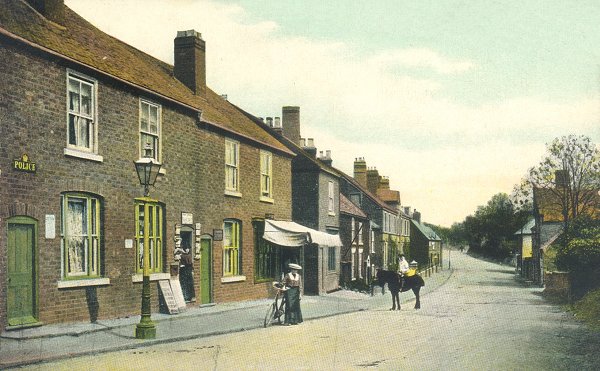 |
A view of the village in the early
1900s, looking towards Roebuck Terrace and the old Roebuck
pub. From an old postcard. |
|
Plans for the building of the existing
Roebuck were submitted in May 1939, and approved the
following month, but the project was abandoned because of
the onset of war. Plans were resubmitted in February 1950,
and building work began in 1955. The new building consisted
of a public bar with a lounge on either side and a
children’s room at the back. When the pub opened, the
original Roebuck, which stood between the new pub and the
Penn Road, was demolished. The old pub had a floor area of
484 square feet, whereas the new pub covered 1,441.5 square
feet. The pub was altered in
1982 when all of the rooms at the front were
converted into one large lounge. The children’s room became an
area for washing up and an extension was built for a
kitchen.
As time progressed, several of the old
cottages and houses were converted into shops. In the mid to
late 1950s the ground floor of the building next to the
Roebuck, known as Roebuck Terrace, was converted into the
shops that are still there today.
Wolverhampton and Dudley Breweries
Limited purchased Roebuck Terrace on 14th November, 1944 for
£2,050. At the time it consisted of seven houses. In 1966
the annual rent for the properties amounted to £3,550.
By that time, traffic on the Penn Road
had increased to such an extent that the narrow road was
over-congested and could not cope with such a large number
of vehicles. Shoppers were almost taking their life in their
hands when they crossed the road at busy times. The pavement
on the east side of the road was extremely narrow and became
a dangerous place for pedestrians.
This changed in the early 1960s when
the dual carriageway was built. The old shops, smithy, and
cottages on the east side were demolished to make way for
the new carriageway. The last trolley bus on the Penn route
ran on 9th June, 1963, and soon after the overhead wires
were removed.
A few years later the modern block of
shops was built on the eastern side of the road, and the
remaining cottages on the other side were demolished to make
way for Woodlands Filling Station, where Tesco now stands.
Woodlands Filling Station was initially owned by Jet, and
later by M.P.K. Garages Limited.
Views of
the village from the Fox & Goose to the Roebuck
The
early 1900s |

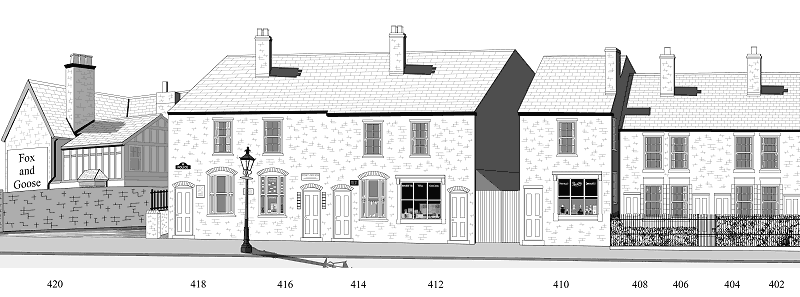
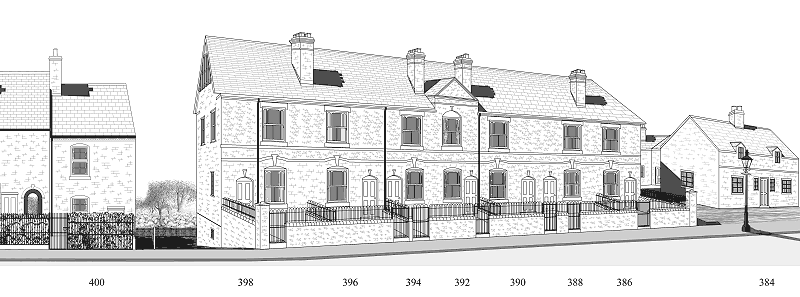
In 1910 the businesses were as follows:
| |
|
|
Number |
|
|
420 |
Fox and Goose. Licensee - Martha Judson |
|
418 |
Police House |
|
416 |
Post Office |
|
412 |
Grocer's shop |
|
410 |
Confectionary shop |
|
384 |
The Roebuck. Licensee - Joseph York |
The village in 1955 |



In 1955 the inhabitants were as follows:
| |
|
|
Number |
|
|
420 |
Fox and Goose. Licensees - William R. Gibbs
and Archie Thom |
|
418 |
Plumber - A. Tudor |
|
416 |
Greengrocer's shop - Mrs. A. Bradley |
|
414 |
? |
|
412 |
Chemist - W. H. Careless |
|
410 |
Stationer, sub post office - Mrs. N. Littler |
|
408 |
Clifford Massey |
|
406 |
William Davies |
|
404 |
Trevor Gregory |
|
402 |
Henry Beech |
|
400 |
George Reid |
|
398 |
Florence Jeavons |
|
396 |
Ernest Smallman |
|
394 |
Plumbers shop - Hickman & Sons |
|
392 |
Newsagent - William P. Skilton |
|
390 |
Greengrocer - Florence Taylor |
|
388 |
Arthur Hutt |
|
386 |
Wilfred Hicks |
|
384 |
The Roebuck. Licensee - John A. Dainty |
The
village in 1963
|

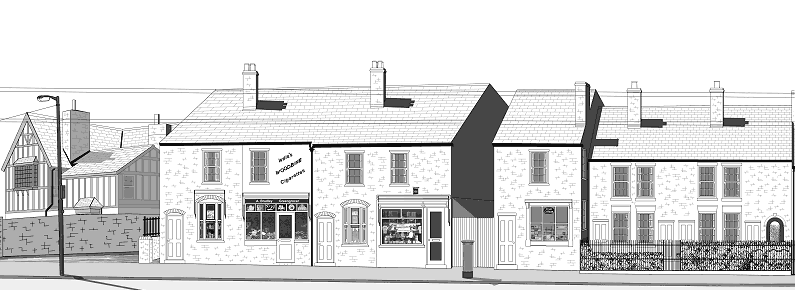
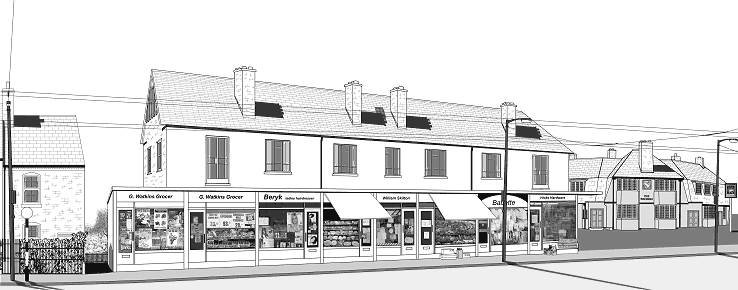
In 1963 the inhabitants were as follows:
| |
|
|
Number |
|
|
420 |
Fox and Goose |
|
418 |
Plumber - A. Tudor |
|
416 |
Greengrocer's shop - Mrs. A. Bradley |
|
414 |
Hairdresser - W. A. Kean |
|
412 |
Chemist - W. H. Careless |
|
410 |
Stationer, sub post office - Mrs. N. Littler |
|
398 |
Grocer - G. Watkins |
|
396 |
Beryk - ladies hairdresser |
|
394 |
Butcher - M. J. Mallin |
|
392 |
Newsagent - William P. Skilton |
|
390 |
Greengrocer - Florence Taylor |
|
388 |
Babette - baby linen |
|
386 |
Hardware - Wilfred Hicks |
|
384 |
The Roebuck |
A view
from 1955 of the east side of the village from Manor
Road to the footpath at the side of Penn U.R.C.
|



In 1955 the inhabitants were as follows:
| |
|
|
Number |
|
|
305 |
J. C. C. Ferguson - Grocer |
|
307 |
Farrier - Butcher |
|
309 |
William A. Kean - Hairdresser |
|
311 |
Percy H. Breakwell |
|
313 |
Funeral Directors - A & T Roden |
|
315 |
A & T Roden |
|
321 |
William Peplow |
|
323 |
Edward Woodhall |
|
325 |
George Corry |
|
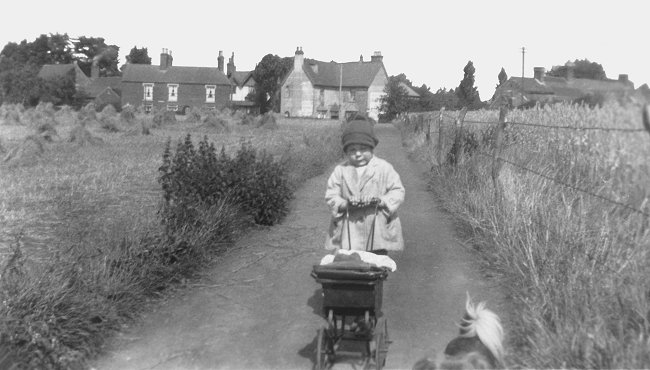 |
A view of a young member of the
Roden family with her dog and pram in about 1926. The girl
is walking along the path that now runs alongside Penn
United Reformed Church. In
the background is the Fox & Goose pub and Woodlands
Cottages. To the left of the pub is the Roden family's first
house on Penn Road. It was demolished in the 1960s. |
|
Prominent Village Families
The Roden Family
Joseph Roden was married in Birmingham,
and later walked to Penn, where he setup his home in
Pennover, Vicarage Road. He was a shoe maker, and Penn
Parish Clerk. His son Henry was born at Pennover on 2nd
January, 1848.
Henry became a blacksmith and initially
worked from the old smithy in Woodlands Cottages. He lived
in a large house next to the smithy, on the Penn Road, on
the opposite side of Woodlands Cottages to the Fox and
Goose. He married twice. His first wife Ester had three
daughters; Lucy, Kate, and Nellie. His second wife, Jayne, a
cook at Muchall Hall, had two sons, Arthur and Tom.
|
| Henry Roden outside his original
forge in Woodlands Cottages by the Fox & Goose. He later
moved to the Penn Road. The old forge was taken over by Tom
Hinsall, a coal merchant. The
building has since been converted into a house. |
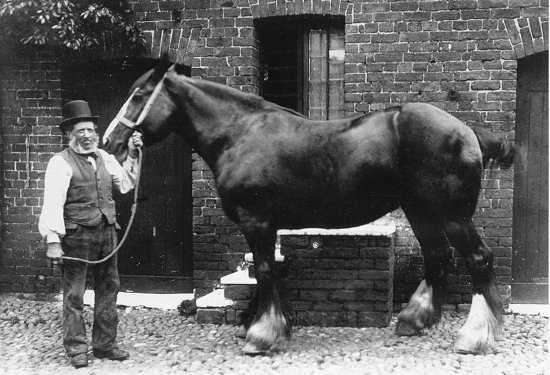 |
|
Within a few years Henry moved to
larger premises on the other side of Penn Road, where the
shops are today. He lived with his family in the house next
to the smithy which he called Penn Forge. His second son Tom
was born there in 1892, a few months before Henry died.
It was a difficult time for Jayne, who
had to bring-up five children, and run the business. She
employed blacksmith Teddy Arthur to work in the forge until
her two sons could take over.
|
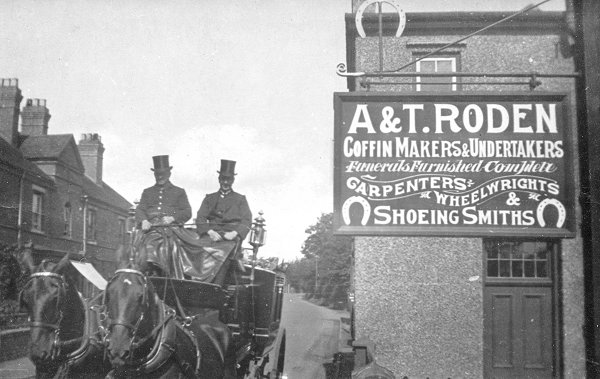 |
The Roden brothers on their
horse-drawn hearse. |
| The Roden brothers' funeral
directors business at 313 Penn Road. |
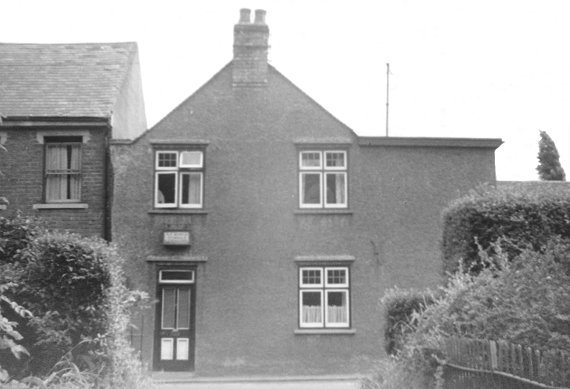 |
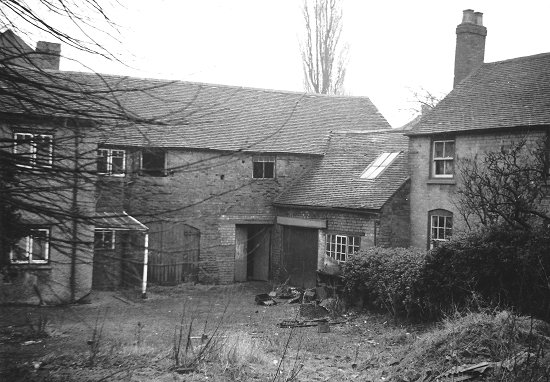 |
Roden's yard, smithy, and house at
315 Penn Road. Photo courtesy
of John Hughes. |
| A view of Penn Road and Roden's
yard. Photo courtesy of John
Hughes. |
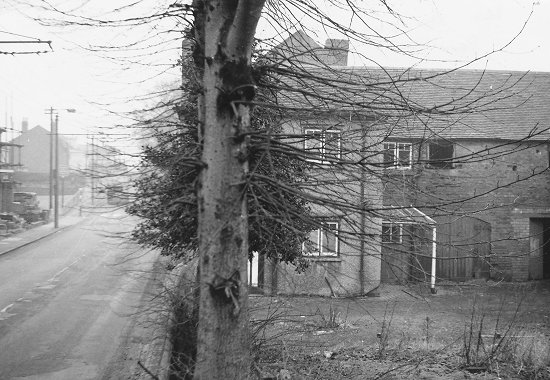 |
| Arthur Roden became a carpenter, and
Tom a blacksmith, after an apprenticeship with a blacksmith
at Wombourne. The two brothers traded as A & T Roden,
blacksmiths, wheelwrights, and undertakers. Tom became a
bell ringer at St. Bart’s Church, something he very much
enjoyed. He served in the First World War, but on his return
found that all the places for bell ringers at St. Bart’s
were taken, so he joined the bell ringers at St. Peter’s
Church in Wolverhampton. |
|
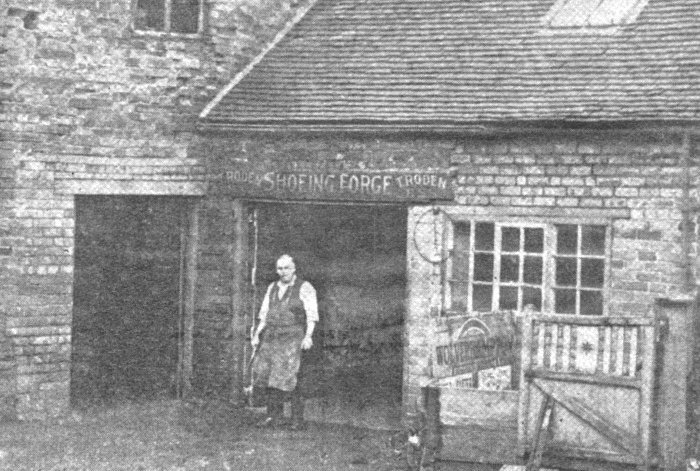
Tom Roden outside his workshop.
From an old newspaper cutting, source unknown. |
|
Tom had two daughters, Dorothy and
Joan. Penn Forge was demolished around 1960 to make way for
the dual carriageway. Tom died in 1974 at the age of 82.
Tom and Arthur’s cousin Harry Roden
lived in a cottage on Church Hill. He was a bee keeper, and
a photographer. He took many photos of old Penn. |
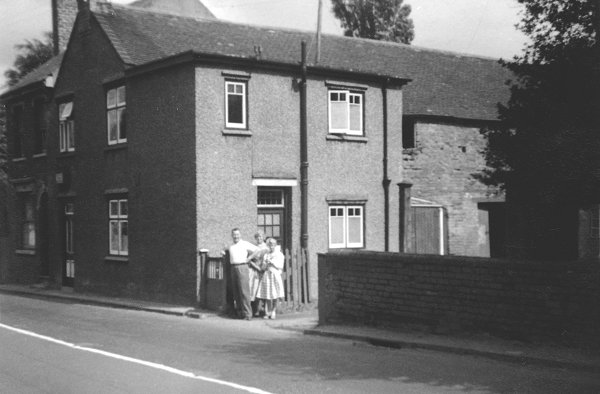 |
Members of the Roden family stood
in the entrance to the yard. |
| The junction of Manor Road and
Penn Road with the once well-known corner shop.
Photo courtesy of John Hughes. |
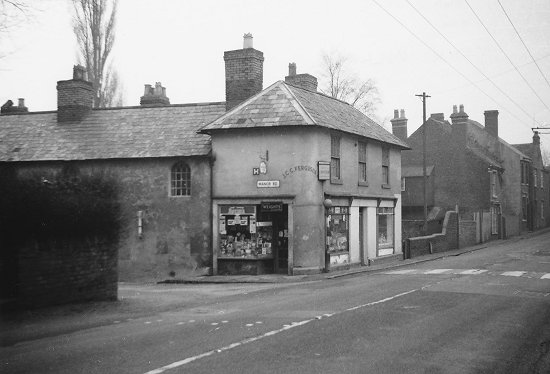 |
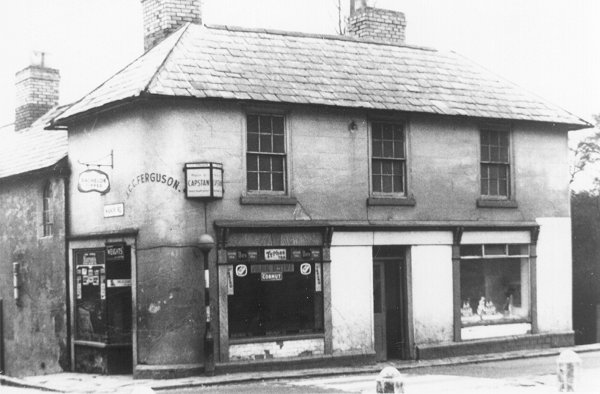 |
The shop that stood on the corner
of Manor Road and Penn Road was run by J. C. C. Ferguson, a
well-known and much liked local character who was known as ‘Fergy’. |
| Looking into Manor Road from The
Roebuck car park, clearly showing Manor Road School.
Photo courtesy of John Hughes. |
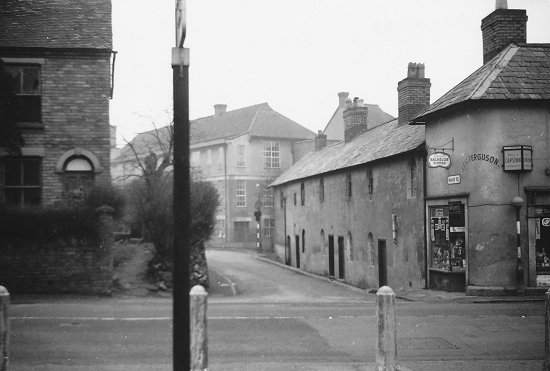 |
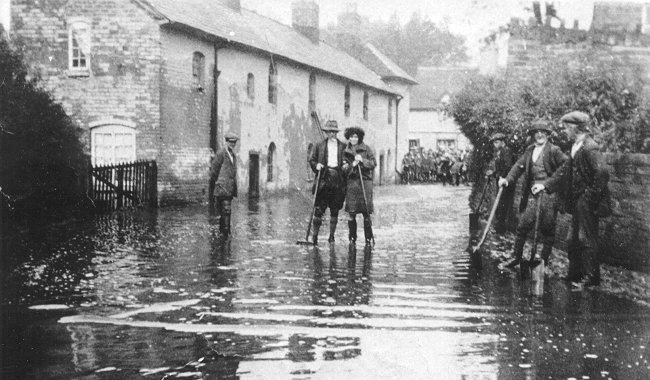 |
A flood at the bottom of Manor
Road in 1927. In the background is the Penn Road and the old
Roebuck. The low-lying area
flooded on many occasions when the watercourses from the
surrounding hills overflowed. |
| The back of the cottages at the
bottom of Manor Road, behind J. C. C. Ferguson’s shop. |
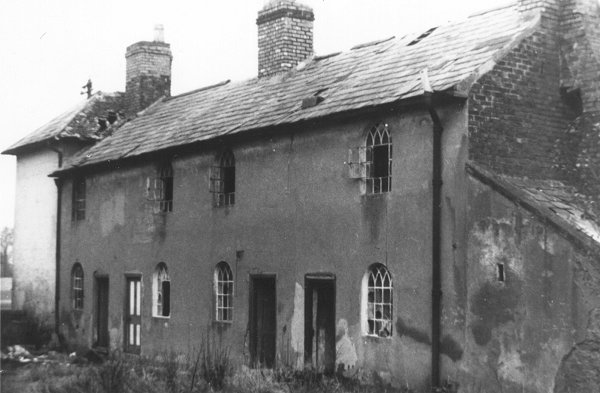 |
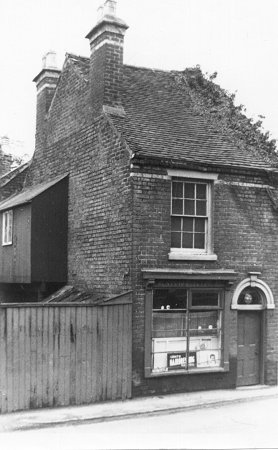
Horace Batkin’s gents hairdressers,
309 Penn Road. |
Horace Charles Batkin was a well known
local personality thanks to his role as the local gents
hairdresser, based at 309 Penn Road. He was born at the
Royal Oak pub in Tettenhall Wood, which was run by his
grandfather. Horace contracted tuberculosis when young, and so
the family were advised to move into the country.
They moved
to Penn, which at the time was still a country village.
Horace attended St. Bart’s School and later became a
hairdresser. He took over an existing barber’s business at
309 Penn Road, which he ran from the front room. The
shop was rented from Miss Hill, who owned the property.
His son Frank described the shop as
follows:
There was a small room equipped with
a sink for washing hair, and of course the barber’s chair.
On the wall hung straps etc. which were used to sharpen his
razors. A large mirror faced the chair with a double-handed
hand mirror by the side.
There were also assorted tapers for
singeing the hair on the nape of the neck after cutting.
There were also cards with combs for sale, and various bits
of equipment such as the hot towel box, and various scissors
for trimming, thinning etc.
There was also the obligatory
broom for sweeping up the remnants of hair, and a large
glass jar containing an antiseptic wash for the combs. There
were hooks for clippers, a hair dryer, and scissors, and
various attachments for the clippers. On the walls were
various adverts and pictures.
|
| In the early 1950s the business was sold to hairdresser
William A. Kean. He ran the business until around 1960 when
the building was demolished to make way for the dual
carriageway. He then moved across the road to number 414.
Horace and his family moved to a new house at Castlecroft, and some time later he opened a barbers shop in
Vane Street, Wolverhampton.
Unfortunately, within a few
years the shop was demolished to make way for the ring road.
Horace tried other work, but sadly died just before
Christmas, 1969, after a short illness. |
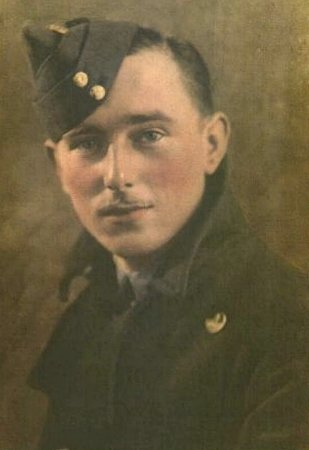
| Horace Charles Batkin
in his RAF uniform. Courtesy of his son Frank. |
|
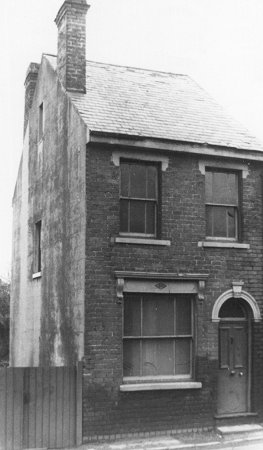 |
|
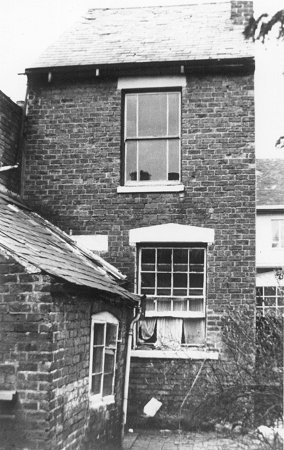 |
|
311 Penn
Road. |
|
The back
of 311 Penn Road. |
|
|
The Rowe Family
Several generations of the Rowe family
lived in the village. In 1842 William Rowe was licensee of
the Rose & Crown. By 1881 it was run by sisters Lucy Simmons
Rowe, Ann Rowe, and Mary Rowe, presumably William’s
children.
Sarah Rowe, her daughter Ann, and son
Charles also lived in the village. Sarah was a laundress,
Anne a parlour maid, and Charles a tin plate worker.
Other family members in Penn included
Martha Rowe, and her sister Anne, both in their 60s when
recorded in the 1881 census. Another family member, Stephen
Rowe, a civil engineer lived at number 1 Church Villas with
his son George, an iron master, and their domestic servant
Elizabeth Wooton. |
| The cottages at 321 to 325 Penn
Road opposite the Fox & Goose.
Photo courtesy of John Hughes. |
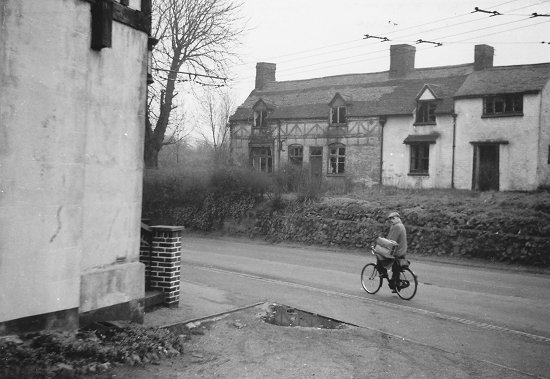 |
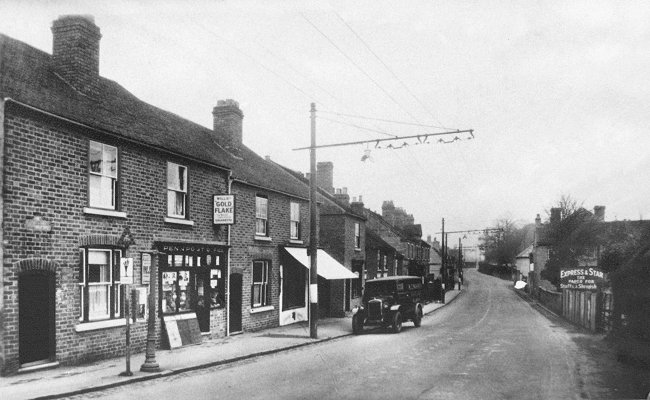 |
Penn village in the mid to late
1930s.
The trolley bus wires greatly
changed the look of the village when they appeared in the
early 1930s.
Trolley buses began running to the
terminus at the top of Lloyd Hill, via Penn Fields on 10th
October 1932. |
| A photograph taken in the 1950s
from the corner of Manor Road and Penn Road.
By this time some of the terraced
houses on the right had already been converted into shops.
Within a few years the building
would be transformed into the row of shops that are there
today. |
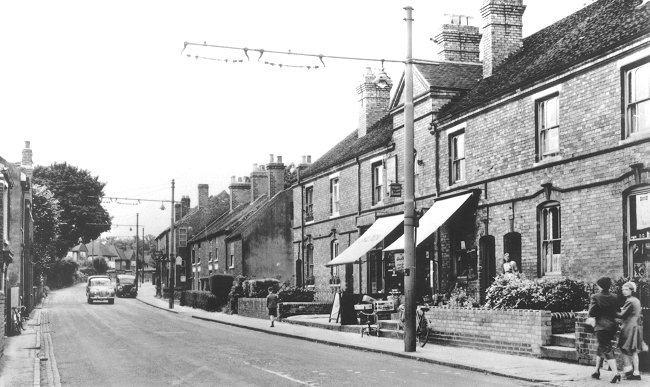 |
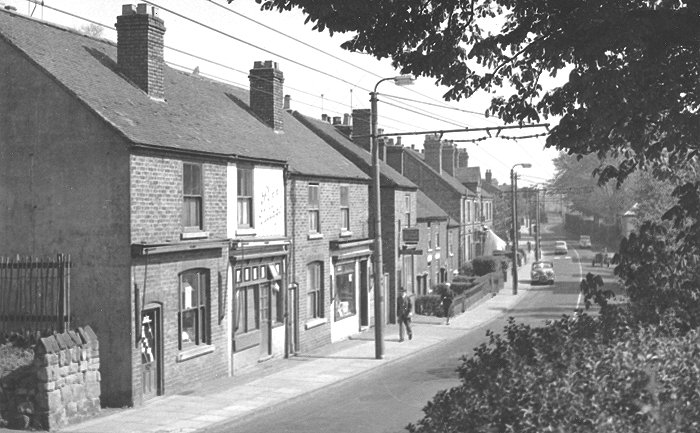 |
A view of the shops and houses
from the early 1960s. |
| The village in the early 1960s
before the dual carriageway, and the end of the
trolleybuses. It is quite a
contrast to the view below taken a few years later. |
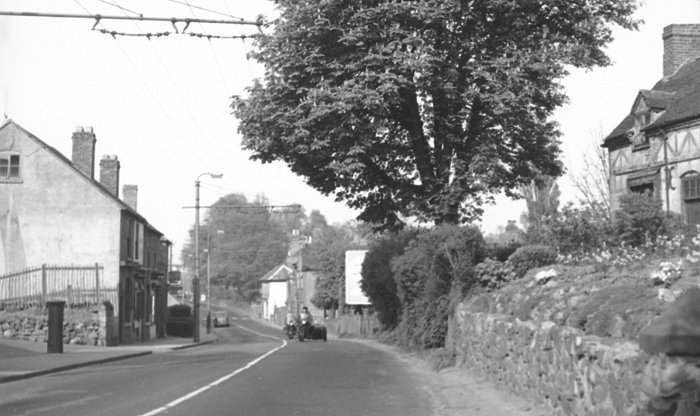 |
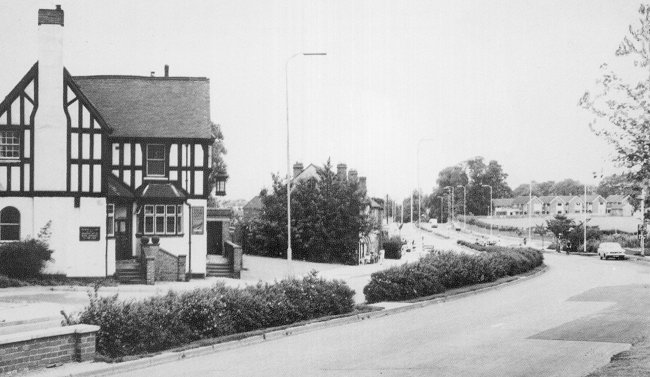 |
Penn Village in 1968.
The modern shops on the eastern
side of Penn Road were still to be built, and the old
cottages across the road were still standing.
Within a few years the village
would be transformed into its current form, except that
Woodlands Filling Station would occupy the site of today’s
Tesco store. |
| The shops in the early 1970s. |
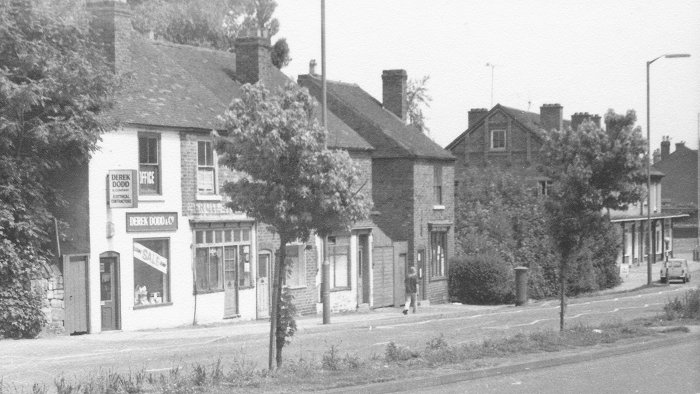 |
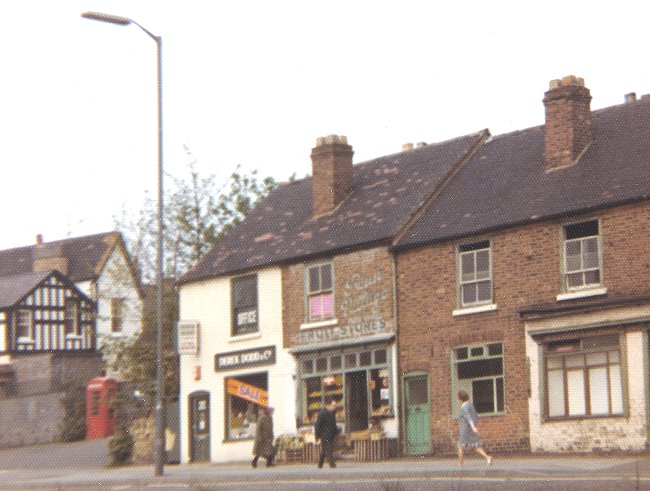 |
A view from May 1973 with the Fox
and Goose on the left. |
| Penn Post Office in May 1973. |
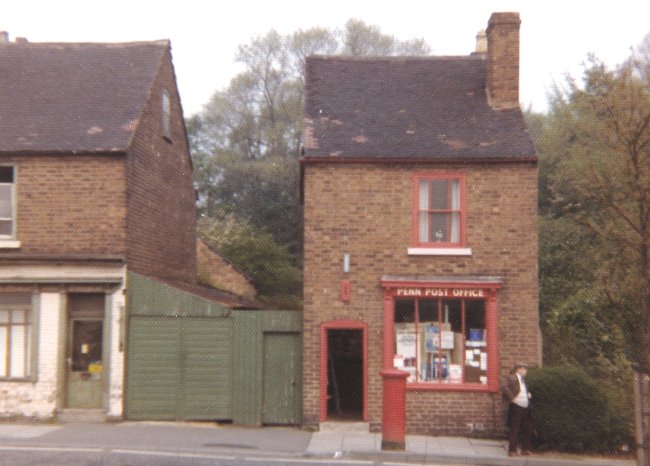 |
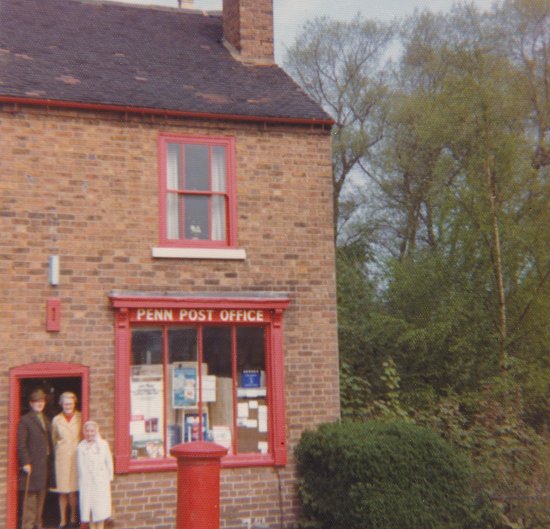 |
Another view of the post office
from May 1973. |
| A final view of the dual
carriageway, from the early 1970s. |
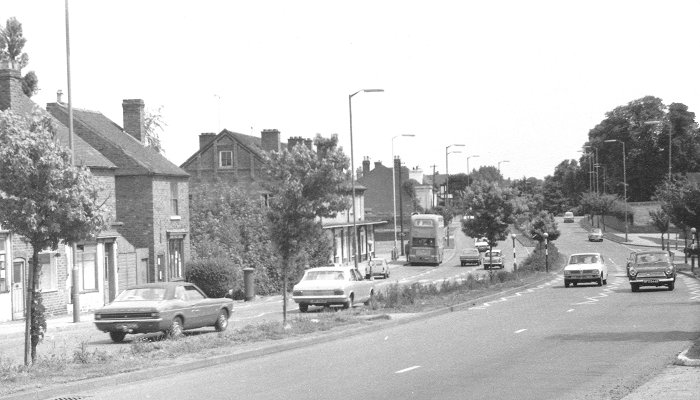 |
 |
Return to
the
previous page |
|